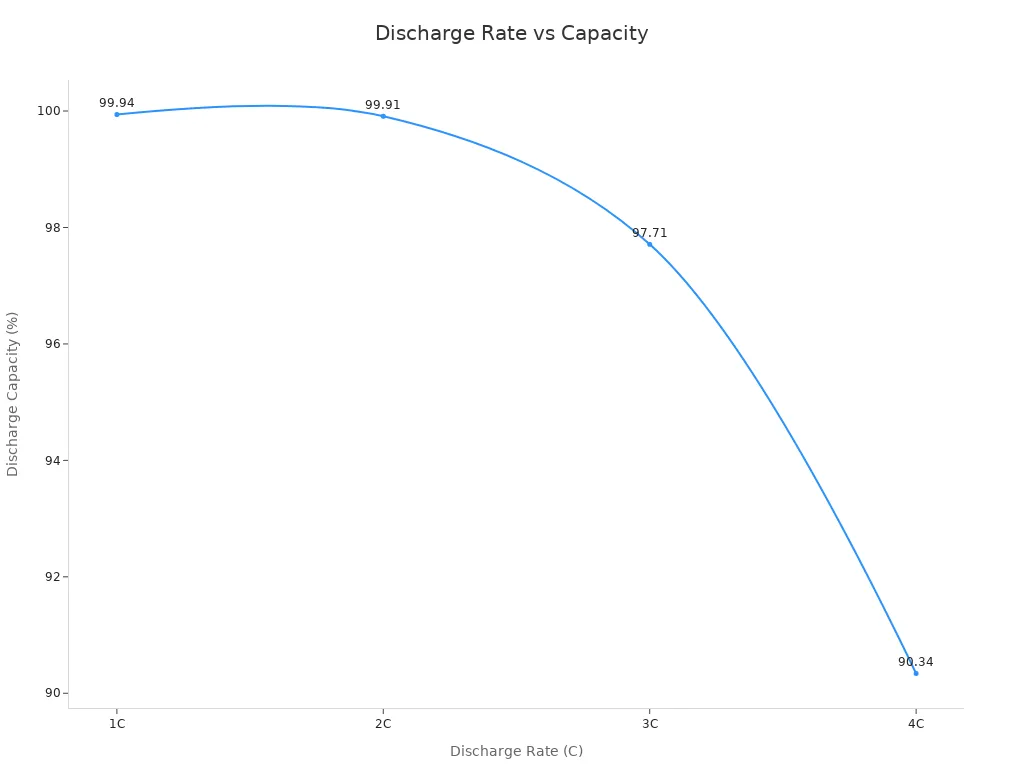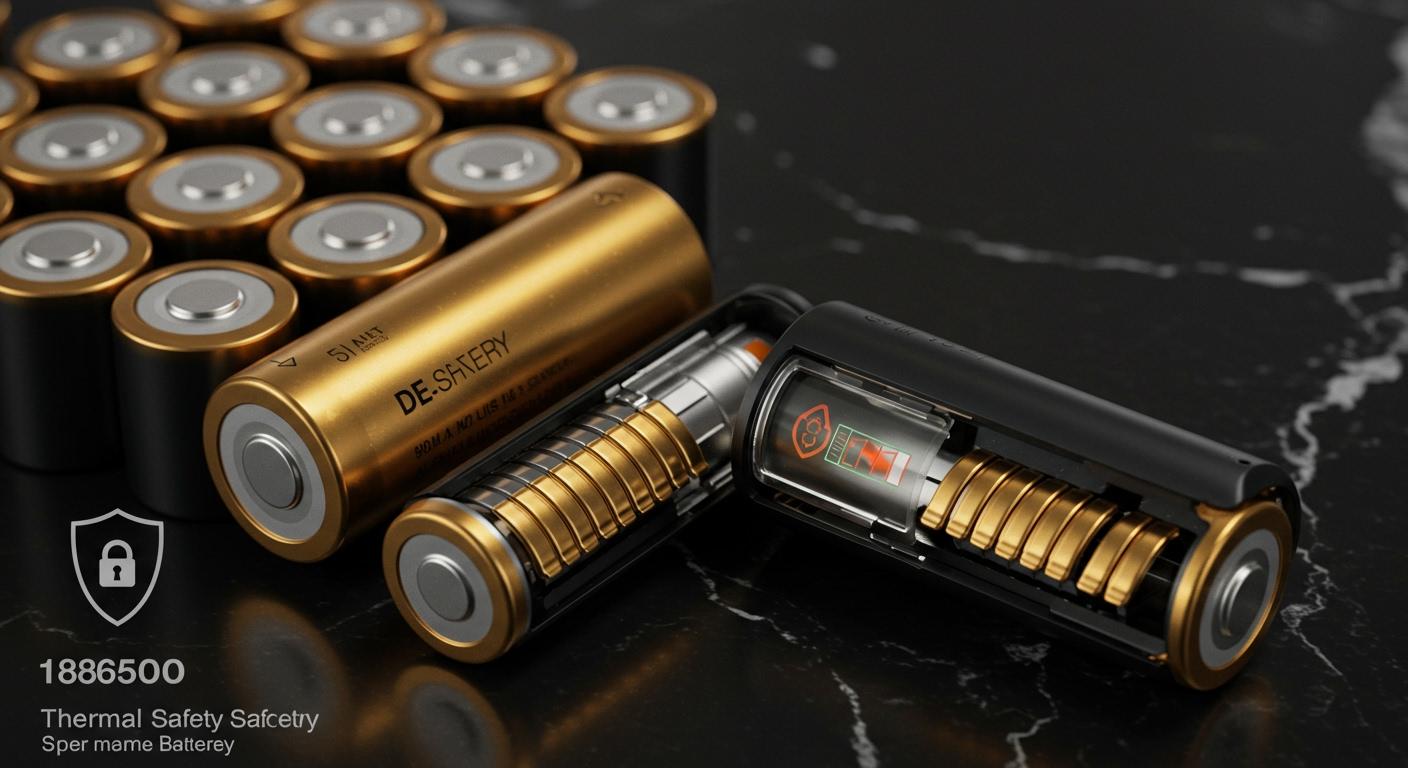Advantages of 18650 Lithium Ion Battery Everyone Should Know for Thermal Safety
One of the key Advantages of 18650 Lithium Ion Battery is their excellent heat management. These batteries are designed to control thermal levels effectively, which is crucial for safety since excessive heat can lead to damage, fire, or even explosions. The optimal operating temperature for 18650 lithium-ion batteries is between 25°C and 40°C. Maintaining a stable temperature not only enhances the Advantages of 18650 Lithium Ion Battery by extending their lifespan but also ensures safe operation.
Always monitor your battery’s temperature. The Advantages of 18650 Lithium Ion Battery include safer usage and greater peace of mind, reducing the risk of potential hazards.
Key Takeaways
- 18650 lithium-ion batteries handle heat well. This helps keep them safe. It also makes them last longer. Always watch your battery's temperature. Keep it between 25°C and 40°C. This stops it from getting too hot. It also helps avoid dangers. Pick batteries with safety features like PTC switches and vents. These help lower the chance of thermal runaway. Use a battery management system, or BMS, to check the temperature. It can turn on cooling systems to make things safer. Store and charge batteries the right way. This keeps them safe and working well. Put them in a cool, dry place. Check them often for any damage.
What Is Thermal Safety?
Definition and Importance
Thermal safety means keeping your lithium-ion battery at a safe temperature. The best range is between 25°C and 40°C. If it gets too hot or too cold, the battery might lose power or become unsafe. It is important to know how heat affects your battery. Too much heat can cause big problems.
Here is a table that explains what experts say about thermal safety for lithium-ion batteries:
| Aspect | Description |
|---|---|
| Risks | Lithium-ion batteries can stop working if they get too hot, are overcharged, over-discharged, or short-circuited. |
| Thermal Runaway | This is when chemical energy turns into heat very fast. It can make the battery very hot and may start a fire. |
| Monitoring Approach | It is important to check the battery’s temperature while it is being used, especially inside the battery. |
| Limitations of Surface Temp | Checking only the outside temperature is not enough. The inside can be much hotter than the outside. |
You should always watch your battery’s temperature. Heat can build up inside even if the outside feels cool. Keeping your battery in the right range helps stop damage and makes it last longer.
Common Risks
When you use lithium-ion batteries, there are some thermal risks. If you do not manage these risks, things can get dangerous.
- Thermal runaway means the battery heats itself up very quickly. It can get hotter by more than 20°C each minute.
- This can make the battery break open, let out smoke, or catch fire.
- Overheating, damage, and battery management system problems are common causes.
- During thermal runaway, the battery can let out gases that burn or are poisonous. These gases can start fires or explosions.
⚠️ Tip: Always pick batteries with safety features and check their temperature. This helps you avoid most risks and keeps you safe.
If you know about these risks and keep your battery at the right temperature, you lower the chance of accidents. You also help your battery work better and last longer.
Advantages of 18650 Lithium Ion Battery for Thermal Safety
Cell Design and Heat Dissipation
The special shape of 18650 lithium-ion batteries helps with heat. Their round shape spreads heat better than other types. Inside, the jelly roll design lets heat move out fast. This helps stop the battery from getting too hot.
Here is a table that shows how the design features help with heat management:
| Design Feature | Description |
|---|---|
| Cell Shape | Cylindrical cells use a wound jelly roll format, which improves heat dissipation compared to stacked formats. |
| Winding Distance (dascs) | The space between windings affects how hot the battery gets during use. Larger gaps can lead to higher temperatures. |
| Production Speed | Wound electrodes allow for faster production, making manufacturing more efficient. |
Experts say the round shape makes heat control easier. Some studies show that special cooling liquids help cool the battery faster. Changing the battery’s shape can also help remove heat. Cooling systems like liquid cooling or phase change materials work well with these batteries.
| Study Title | Key Findings |
|---|---|
| Thermal management improvement for a pack of cylindrical batteries using nanofluids and topological modifications | Topological changes and nanofluids boost heat transfer, helping keep batteries cool. |
| Thermal management of cylindrical lithium-ion batteries with different fin configurations and phase change material | Different cooling setups improve heat dissipation for 18650 batteries. |
| Development and Analysis of a New Cylindrical Lithium-Ion Battery Thermal Management System | Liquid cooling systems control heat well in 18650 batteries, showing the value of the cylindrical shape. |
Using 18650 batteries gives you better heat control. This makes them safer to use. The design helps stop overheating and thermal runaway.
Safety Features
18650 lithium-ion batteries have built-in safety features. These features help stop dangerous problems before they start. Most 18650 batteries have a PTC switch, a CID device, and vents.
Here is a table that explains these safety features:
| Safety Feature | Description |
|---|---|
| PTC (Pressure, Temperature, Current) Switch | Stops high current surges and protects against too much pressure or heat. Resets after use but increases resistance. |
| CID (Current Interrupt Device) | Acts as a pressure valve. Shuts down the battery if pressure gets too high. May not reset after activation. |
| Vents | Small holes at the top release toxic chemicals safely, preventing explosions. |
These parts work together to keep you safe. The PTC switch and CID device act fast if things get too hot or there is too much pressure. Vents let out gases so the battery does not blow up. Some batteries use fiber optic sensors to warn you early about thermal runaway. Fire prevention technology helps lower damage if something goes wrong. Thermal management systems keep the battery at a safe temperature.
? Tip: Pick batteries with these safety features. You lower your risk and get the advantages of 18650 lithium ion battery for daily use.
Quality Control
Manufacturers follow strict rules to make sure batteries work well. These rules help stop problems like short circuits and overheating. Companies try hard to keep metal bits out of the battery, which lowers the chance of failure.
Here are some common quality control steps:
- Manufacturers reduce metallic particles to prevent short circuits.
- New UL safety standards remove the need for penetration tests, making batteries safer.
- Battery samples must pass tough tests, with a million samples showing no failures over a year for critical uses.
- Pre-testing includes visual checks, temperature and pressure monitoring, and abuse tests to find safety limits.
- Technicians use calibrated tools for accurate measurements and keep detailed records.
- Safety comes first. Workers wear protective gear and follow best practices.
- Strict quality control during manufacturing improves safety and reliability.
International certifications are important too. Look for these marks to know your battery is safe:
| Certification | Description |
|---|---|
| UL 1642 & UL 2054 | Require tough safety tests for cells and packs, checking for overheating and short circuits. |
| UN/DOT 38.3 | Makes sure batteries can handle shipping conditions like pressure changes and shaking. |
| CE Marking & EN Standards | Show that batteries meet health, safety, and environmental rules. |
| IEC 62619 | Ensures safe use in tough industrial settings. |
| PSE Mark | Tests for overcharging, short-circuit prevention, and thermal management. |
| IEC 62133 | Sets safety and performance rules for portable lithium-ion batteries. |
You get the advantages of 18650 lithium ion battery because these tests and rules make sure your battery is safe and works well.
BMS Compatibility
You can make batteries even safer by using a battery management system (BMS). The BMS checks temperature sensors and turns on cooling when needed. This keeps your battery at the right temperature.
Here are some ways a smart BMS helps you:
- Monitors temperature sensors and activates cooling systems to keep batteries safe.
- Controls cooling fans or liquid cooling systems to prevent overheating.
- Adjusts cooling speed to match battery needs, stopping thermal runaway before it starts.
You get the advantages of 18650 lithium ion battery when you use a good BMS. The system helps stop overheating and keeps your battery working longer.
?️ Note: Always use a BMS with your battery packs. You protect yourself and your devices from thermal risks.
Choosing 18650 lithium-ion batteries gives you strong thermal safety. Smart design, built-in features, strict quality control, and advanced BMS compatibility all help. These advantages of 18650 lithium ion battery make them a great choice for safe and reliable power.
Real-World Impact

Overheating Prevention
Thermal safety helps 18650 lithium-ion batteries stop overheating. Many companies use special cooling systems to keep batteries safe. These systems use phase change materials and mini-channels together.
- Phase change materials soak up extra heat when batteries work hard.
- Mini-channels move cooling liquid fast around each battery cell.
- A parallel cooling setup lets heat leave quickly, so PCM does not trap it.
- Keeping battery cells, PCM, and liquid channels apart makes fixing things easier and lowers the chance of thermal runaway.
If your battery has these features, it is less likely to overheat. Your devices stay safe.
High-Drain Performance
Thermal safety is very important for high-drain devices. The 18650 battery can give out power fast and still stay cool. This means you get strong power without danger.
Here is a table that shows how discharge rate changes temperature and safety:
| Discharge Rate (C) | Discharge Capacity (%) | Temperature Fluctuation | Thermal Risk Assessment |
|---|---|---|---|
| 1 | 99.94 | Low | Safe |
| 2 | 99.91 | Low | Safe |
| 3 | 97.71 | Moderate | Manageable |
| 4 | 90.34 | High | Risky |

You can trust these batteries in electric cars and tools. Even when you use them a lot, safety features help keep them cool.
Lifespan and Reliability
Thermal safety makes your battery last longer and work better. High-drain 18650 batteries give quick energy and keep working under stress.
- You can use them in power tools and vaping mods that need fast energy.
- These batteries stay strong, even with lots of use.
Studies show that watching heat inside the battery helps you use it safely.
| Key Findings | Description |
|---|---|
| Thermal Evolution Behavior | You can see how heat changes during use, which helps stop damage. |
| Safe Utilization Insights | Learning about safe use keeps your battery working longer. |
| Critical External Heat | Keeping outside heat low stops fires and explosions. |
| Application in Various Fields | You can use these batteries in electronics and electric cars. |
The Advantages of 18650 Lithium Ion Battery are better safety, longer life, and strong performance. Picking batteries with good thermal safety protects you and your devices.
Maximizing Safety
Usage Tips
You can keep your 18650 lithium-ion batteries safe by doing a few easy things. Always look at your batteries before you use them. Check for swelling, leaks, or damage. If you see any problems, stop using the battery right away.
Here are some simple ways to use your batteries safely:
- Store batteries with 40%–60% charge to stop over-discharge.
- Keep batteries at room temperature, between 20°C and 25°C (68°F–77°F).
- Use battery cases so you do not get short circuits.
- Check batteries for swelling or damage every time you use them.
- Keep humidity under 50% to stop moisture damage.
?️ Tip: Never use a battery that is damaged. Always keep batteries away from metal things like keys or coins.
Many battery packs have safety features built in. These features help protect you from accidents. For example, protection circuits limit current and stop the battery if there is a problem. The table below shows how these features help:
| Feature | Description |
|---|---|
| Current Restriction | Stops too much current, which can prevent sparks or explosions. |
| Fault Detection | Shuts off the battery if it detects a problem, keeping your device safe. |
| Size Variability | Fits different devices, so you get safety no matter what you use. |
Storage and Charging
Storing and charging your batteries the right way keeps them safe and helps them last longer. Always put batteries in a cool, dry place away from sunlight. Use special containers for batteries to stop damage.
Follow these steps for safe storage:
- Store batteries at 20°C to 25°C (68°F to 77°F).
- Keep batteries at about 50% charge for best performance.
- Cover battery ends with insulating material.
- Do not mix different brands or charge levels.
- Check batteries often for leaks or swelling.
When you charge batteries, use the right charger and watch the temperature. The best charging range is 0°C to 45°C (32°F to 113°F). Charging outside this range can hurt your battery or cause safety problems. Some batteries have sensors inside to check temperature. These sensors help stop overheating and keep you safe.
⚡ Note: Always charge batteries in a safe place and never leave them alone. If you see overheating or swelling, stop charging right away.
If you follow these tips, you can enjoy the advantages of 18650 lithium ion battery and keep yourself and your devices safe.
You get thermal safety from 18650 lithium-ion batteries. These batteries have temperature sensors and fuses to help keep you safe. They also use overcharge protection circuits. Battery management systems watch charging and discharging. This gives you more peace of mind.
| Incident | Manufacturer | Impact on Consumer Behavior |
|---|---|---|
| Recall of almost six million lithium-ion packs | Dell and Apple | People became more careful and wanted safer batteries |
- You might pick batteries from brands you trust that follow safety rules.
- Many people are willing to pay extra for safer batteries.
New ideas like phase change materials and smart BMS make batteries even safer. If you use 18650 lithium-ion batteries and follow safety tips, you help protect yourself and your devices from heat dangers.
-

 May.2025.11.24Ternary Lithium Battery vs Lithium-ion: Complete Comparison Guide (2025 Edition)Learn More
May.2025.11.24Ternary Lithium Battery vs Lithium-ion: Complete Comparison Guide (2025 Edition)Learn More -

 May.2025.11.214S2P 18650 14.8V Battery: Complete Technical Guide, Specs, Applications & SafetyLearn More
May.2025.11.214S2P 18650 14.8V Battery: Complete Technical Guide, Specs, Applications & SafetyLearn More -

 May.2025.11.18PCM vs BMS in Lithium Batteries: What’s the Difference and Which One Do You Need?Learn More
May.2025.11.18PCM vs BMS in Lithium Batteries: What’s the Difference and Which One Do You Need?Learn More -

 May.2025.11.17Custom Li-ion Battery Design for Medical Devices (2025 Comprehensive Guide)Learn More
May.2025.11.17Custom Li-ion Battery Design for Medical Devices (2025 Comprehensive Guide)Learn More -

 May.2025.11.17The Future of Lithium-Ion Batteries: Innovation, Sustainability, and Global Market TrendsLearn More
May.2025.11.17The Future of Lithium-Ion Batteries: Innovation, Sustainability, and Global Market TrendsLearn More
















